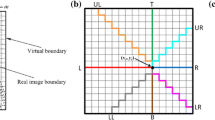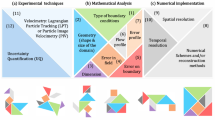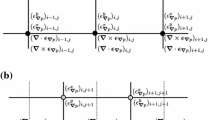Abstract
The introduction of 3D time-resolved velocity measurement techniques enables calculation of the instantaneous pressure distribution by spatially integrating the material acceleration. This paper introduces an efficient method for 3D integration of the acceleration, which does not require prescribed Dirichlet boundary condition on one of the surfaces, minimizes the propagation of errors in acceleration, and can be easily utilized in flows with complex boundaries. This parallel-line, omni-directional integration procedure (Omni3D) calculates the pressure at every point by integration from all directions, while avoiding regions with large acceleration errors. To reduce the computational costs, the calculations are performed by a GPU-based algorithm, which determines the 3D pressure field from tomographic PIV data in 1 min. The accuracy of Omni3D is compared to that of several techniques, including procedures based on solving the Pressure Poisson Equation (PPE) with different Dirichlet boundary conditions. The error analysis is based on Direct Numerical Simulation (DNS) data for isotropic turbulence, synthetic 3D PIV images for turbulent channel flow generated from DNS data, and experimental data. It examines the effects of spatial resolution, propagation, and avoidance of embedded local errors, boundary conditions, method for calculating the velocity, as well as viscous and sub-grid stresses on the calculated pressures. For acceleration fields with low errors and properly specified boundary conditions, Omni3D and PPE give similar results. However, Omni3D is more effective in suppressing the effects of acceleration errors. Sample experimental results including instantaneous plot of pressure, pressure statistics, and pressure–velocity correlations based on tomographic PIV data are also provided.
Graphical abstract


















Similar content being viewed by others
References
Atkinson C, Coudert S, Foucaut JM et al (2011) The accuracy of tomographic particle image velocimetry for measurements of a turbulent boundary layer. Exp Fluids 50:1031–1056
Batchelor GK (1951) Pressure fluctuations in isotropic turbulence. Proc Cambridge Phil Soc 47(2):359–374
Baur T, Köngeter J (1999) PIV with high temporal resolution for the determination of local pressure reductions from coherent turbulent phenomena. In: 3rd international workshop on particle image velocimetry. Santa Barbara, CA, 16–18 September 1999
Blake W (2017) Mechanics of flow-induced sound and vibration. Academic Press, Cambridge
Bukov AP, Orlov AA, Mosharov VE, Radchenko VN, Pesetsky VA, Sorokin AV, Phonov SD, Alaty L, Colucci V(1992) Application of luminescent quenching for pressure field measurements on the model surface in a wind tunnel. In: Wind tunnels and wind tunnel test techniques; proceedings of the conference, Southampton, United Kingdom, 14–17 September 1992
Bull MK (1996) Wall-pressure fluctuations beneath turbulent boundary layers: some reflections on forty years of research. J Sound Vib 190(3):299–315
Charonko JJ, King CV, Smith BL, Vlachos PP (2010) Assessment of pressure field calculations from particle image velocimetry measurements. Meas Sci Technol 21:105401
Corcos GM (1963) Resolution of pressure in turbulence. J Acoustic Soc Am 35:192–199
de Kat R, van Oudheusden BW (2012) Instantaneous planar pressure determination from PIV in turbulent flow. Exp Fluids 52:1089–1106
de Silva M, Baidya R, Khashehchi M, Marusic I (2011) Assessment of tomographic PIV in wall-bounded turbulence using direct numerical simulation data. Exp Fluids 52:425–440
Elsinga GE, Scarano F, Wieneke B, van Oudheusden BW (2005) Tomographic particle image velocimetry. In: 6th international symposium on particle image velocimetry. Pasadena, California, USA, 21–23 September 2005
Ghaemi S, Scarano F (2013) Turbulent structure of high-amplitude pressure peaks within the turbulent boundary layer. J Fluid Mech 735:381–426
Ghaemi S, Ragni D, Scarano F (2012) PIV-based pressure fluctuations in the turbulent boundary layer. Exp Fluids 53(6):1823–1840
Golub GH, Loan CFV (1996) Matrix computation. JHU Press, Baltimore
Graham J, Kanov K, Yang XIA, Lee MK, Malaya N, Lalescu CC, Burns R, Eyink G, Szalay A, Moser RD, Meneveau C (2016) A Web Services-accessible database of turbulent channel flow and its use for testing a new integral wall model for LES. J Turbul 17(2):181–215
Huhn F, Schanz D, Gesemann S, Manovski P, Schröder A (2016) Pressure re construction from Lagrangian particle tracking with FFT integration. In: 18th international symposium on the application of laser and imaging techniques to fluid mechanics. Lisbon, Portugal, 4–7 July 2016
Jeon YJ, Tronchin T, Chatellier L, David L (2014) 3D extension of the fluid trajectory evaluation based on an ensemble averaged cross-correlation (FTEE) for acceleration and pressure. In: 17th international symposium on applications of laser techniques to fluid mechanics. Lisbon, Portugal, 07–10 July 2014
Jeon Y, Earl T, Braud P, Chatellier L, David L (2016) 3D pressure field around an inclined airfoil by tomographic TR-PIV and its comparison with direct pressure measurements. In: 18th international symposium on the application of laser and imaging techniques to fluid mechanics. Lisbon, Portugal, 4–7 July 2016
Jimenez J, Hoyas S (2008) Turbulent fluctuations above the buffer layer of wall-bounded flows. J Fluid Mech 611:215–236
Joshi P, Liu X, Katz J (2014) Effect of mean and fluctuating pressure gradients on boundary layer turbulence. J Fluid Mech 748:36–84
Kim KC, Adrian RJ (1999) Very large-scale motion in the outer layer. Phys Fluids 11(2):417–422
Kobashi Y, Ichijo M (1986) Wall pressure and its relation to turbulent structure of a boundary layer. Exp Fluids 4:49–55
Lecordier B, Westerweel J (2004) The EUROPIV Synthetic Image Generator (S.I.G.). In: Proceedings of the EUROPIV 2 workshop, Zaragoza, Spain, 31 March–1 April 2003
Lesieur M, Mètais O (1996) New trends in large-eddy simulations of turbulence. Ann Rev Fluid Mech 28:45–82
Li Y, Perlman E, Wan M, Yang Y, Burns R, Meneveau C, Burns R, Chen S, Szalay A, Eyink G (2008) A public turbulence database cluster and applications to study Lagrangian evolution of velocity increments in turbulence. J Turbul 9:1–29
Liu X, Katz J (2006) Instantaneous pressure and material acceleration measurements using a four-exposure PIV system. Exp Fluids 41(2):227–240
Liu X, Katz J (2008) Cavitation phenomena occurring due to interaction of shear layer vortices with the trailing corner of a two-dimensional open cavity. Phys Fluids 20(4):041702–041702
Liu X, Katz J (2013) Vortex-corner interactions in a cavity shear layer elucidated by time-resolved measurements of the pressure field. J Fluid Mech 728:417–457
Liu X, Katz J (2017) Pressure–rate-of-strain, pressure diffusion, and velocity–pressure-gradient tensor measurements in a cavity flow. In: 55th AIAA aerospace sciences meeting AIAA SciTech forum, Grapevine, Texas, 9–13 January 2017
Liu S, Meneveau C, Katz J (1994) On the properties of similarity subgrid-scale models as deduced from measurements in a turbulent jet. J Fluid Mech 275:83–119
Liu X, Moreto JR, Siddle-Mitchell S (2016) Instantaneous pressure reconstruction from measured pressure gradient using rotating parallel ray method. In: 54th AIAA aerospace sciences meeting, San Diego, California, USA, 4–8 January 2016
Lynch K, Scarano F (2013) A high-order time-accurate interrogation method for time-resolved PIV. Meas Sci Technol 24:035305
Lynch K, Scarano F (2014) Material acceleration estimation by four-pulse tomo-PIV. Meas Sci Technol 25:084005
Morris MJ (1995) Use of pressure-sensitive paints in low speed flows. In: IEEE 16th International Congress on Instrumentation in Aerospace Simulation Facilities (ICIASF), Wright-Patterson AFB, OH, 18–21 July 1995
Naka Y, Stanislas M, Foucaut J, Coudert S, Laval J, Obi S (2015) Space–time pressure–velocity correlations in a turbulent boundary layer. J Fluid Mech 771:624–675
Neeteson N, Rival D (2015) Pressure-field extraction on unstructured flow data using a Voronoi tessellation-based networking algorithm: a proof-of-principle study. Exp Fluids 56:44–57
Panton RL, Goldamn AL, Lowery RL, Reischman MM (1980) Low-frequency pressure fluctuations in axisymmetric turbulent boundary layers. J Fluid Mech 97:299–319
Perlman E, Burns R, Li Y, Meneveau C (2007) Data exploration of turbulence simulations using a database cluster. In: Supercomputing SC07 ACM IEEE, Reno, NV, USA, 10–16 Nov. 2007
Peterson JI, Fitzgerald VF (1980) New technique of surface flow visualization based on oxygen quenching of fluorescence. Rev Sci Instrum 51:670–671
Pope SB (2000) Turbulent flows. Cambridge University Press, Cambridge
Roache PJ (1976) Computational fluid dynamics, Hermosa Publs, Albuquerque, NM
Rogallo R, Moin P (1984) Numerical simulation of turbulent flows. Ann Rev Fluid Mech 16:99–137
Schanz D, Gesemann S, Schröder A (2016) Shake-the-box: Lagrangian particle tracking at high particle image densities. Exp Fluids 57:70–97
Schneiders JFG, Pröbsting S, Dwight RP, van Oudheusden BW, Scarano F (2016) Pressure estimation from single-snapshot tomographic PIV in a turbulent boundary layer. Exp Fluids 57(4):–53
Sexton MR, O’Brien WF, Moses HL (1973) An on Rotor Investigation of Rotating Stall in an Axial Compressor. Defense Technical Information Center (DTIC) Technical Report, Cameron Station, Alexandria, VA
Sheng J, Malkiel E, Katz J (2006) Digital holographic microscope for measuring three-dimensional particle distributions and motions. Applied optics 45:3893–3901
Spanier EH (1966) Algebraic topology. Springer, New York
Stanislas M, Okamoto K, Kähler CJ, Westerweel J (2005) Main results of the second international PIV challenge. Exp Fluids 39:170–191
Talapatra S, Katz J (2013) Three-dimensional velocity measurements in a roughness sublayer using microscopic digital inline holography and optical index matching. Meas Sci Technol 24:024004
Tronchin T, David L, Farcy A (2015) Evaluation of pressure field and fluid forces for 3D flow around flapping wing. Exp Fluids 56:7–23
Tsuji Y, Ishihara T (2003) Similarity scaling of pressure fluctuation in turbulence. Phys Rev E 68:026309
Tsuji Y, Fransson JHM, Alfredsson PH, Johansson V (2007) Pressure statistics and their scaling in high-Reynolds-number turbulent boundary layers. J Fluid Mech 585:1–40
van Oudheusden BW (2013) PIV-based pressure measurement. Meas Sci Technol 24(3):32001
van Oudheusden BW, Scarano F, Roosenboom E, Casimiri EWF, Souverein LJ (2007) Evaluation of integral forces and pressure fields from planar velocimetry data for incompressible and compressible flows. Exp Fluids 43:1–12
van Gent LP, Michaelis D, van Oudheusden BW, Weiss PE, de Kat R, Laskari A, Jeon Y, David L, Schanz D, Huhn F, Gesemann S, Novara M, McPhaden C, Neeteson N, Rival DE, Schneiders JFG, Schrijer FFJ (2017) Comparative assessment of pressure feld reconstructions from particle image velocimetry measurements and Lagrangian particle tracking. Exp Fluids 58:33–56
Villegas A, Diez FJ (2014) Evaluation of unsteady pressure fields and forces in rotating airfoils from time-resolved PIV. Exp Fluids 55(4):1–17
Violato D, Moore P, Scarano F (2011) Lagrangian and Eulerian pressure field evaluation of rod-airfoil flow from time-resolved tomographic PIV. Exp Fluids 50(4):1057–1070
Willmarth WW (1975) Pressure Fluctuations Beneath Turbulent Boundary Layers. Annu Rev Fluid Mech 7:13–36
Worth NA, Nickels TB, Swaminathan N (2010) A tomographic PIV resolution study based on homogeneous isotropic turbulence DNS data. Exp Fluids 49:637–656
Yu H, Kanov K, Perlman E, Graham J, Frederix E, Burns R, Szalay A, Eyink G, Meneveau C (2012) Studying Lagrangian dynamics of turbulence using on-demand fluid particle tracking in a public turbulence database. J Turbul 13:1–29
Zhang C, Miorini R, Katz J (2015) Integrating Mach–Zehnder interferometry with TPIV to measure the time-resolved deformation of a compliant wall along with the 3D velocity feld in a turbulent channel flow. Exp Fluids 56:203–225
Zhang C, Wang J, Blake W, Katz J (2017) Deformation of a compliant wall in a turbulent channel flow. J Fluid Mech 823:345–390
Acknowledgements
This research has been sponsored by the Office of Naval Research under Grant no. N00014-16-1-2300. The program officer is Debbie Nalchajian.
Author information
Authors and Affiliations
Corresponding author
Additional information
Publisher’s Note
Springer Nature remains neutral with regard to jurisdictional claims in published maps and institutional affiliations.
Rights and permissions
About this article
Cite this article
Wang, J., Zhang, C. & Katz, J. GPU-based, parallel-line, omni-directional integration of measured pressure gradient field to obtain the 3D pressure distribution. Exp Fluids 60, 58 (2019). https://doi.org/10.1007/s00348-019-2700-y
Received:
Revised:
Accepted:
Published:
DOI: https://doi.org/10.1007/s00348-019-2700-y




